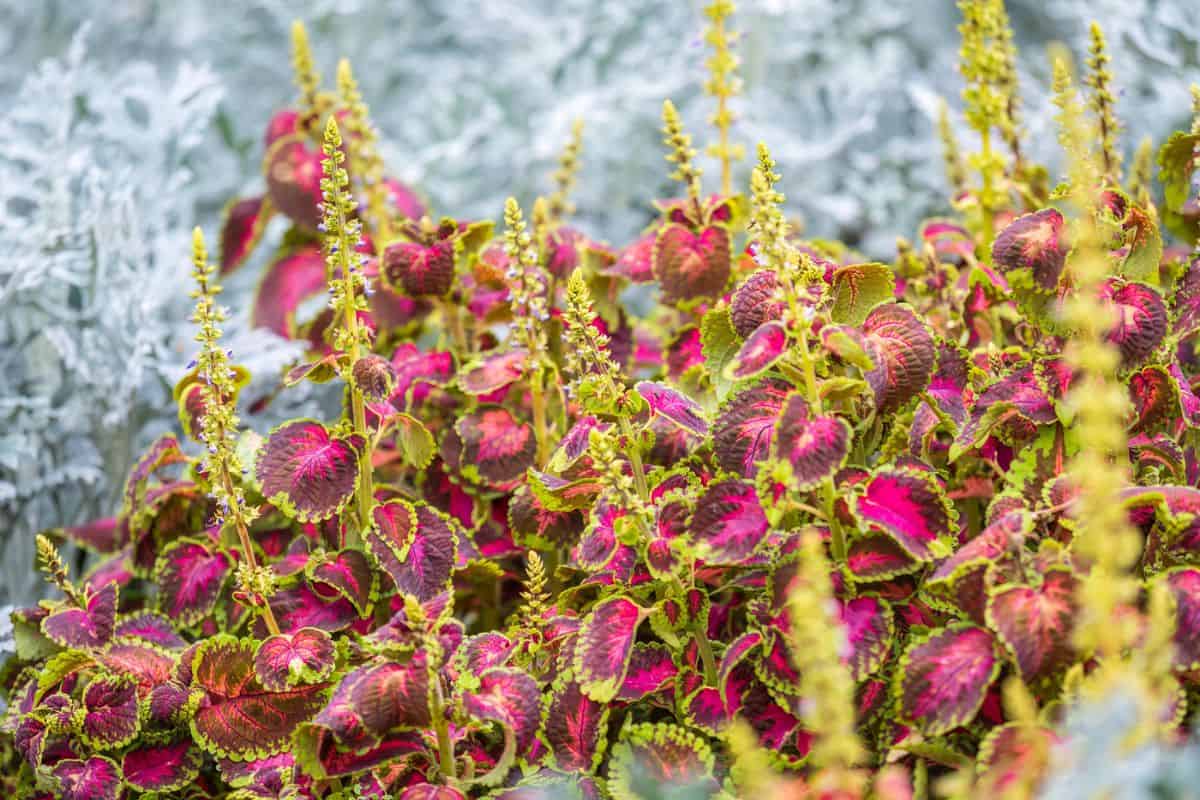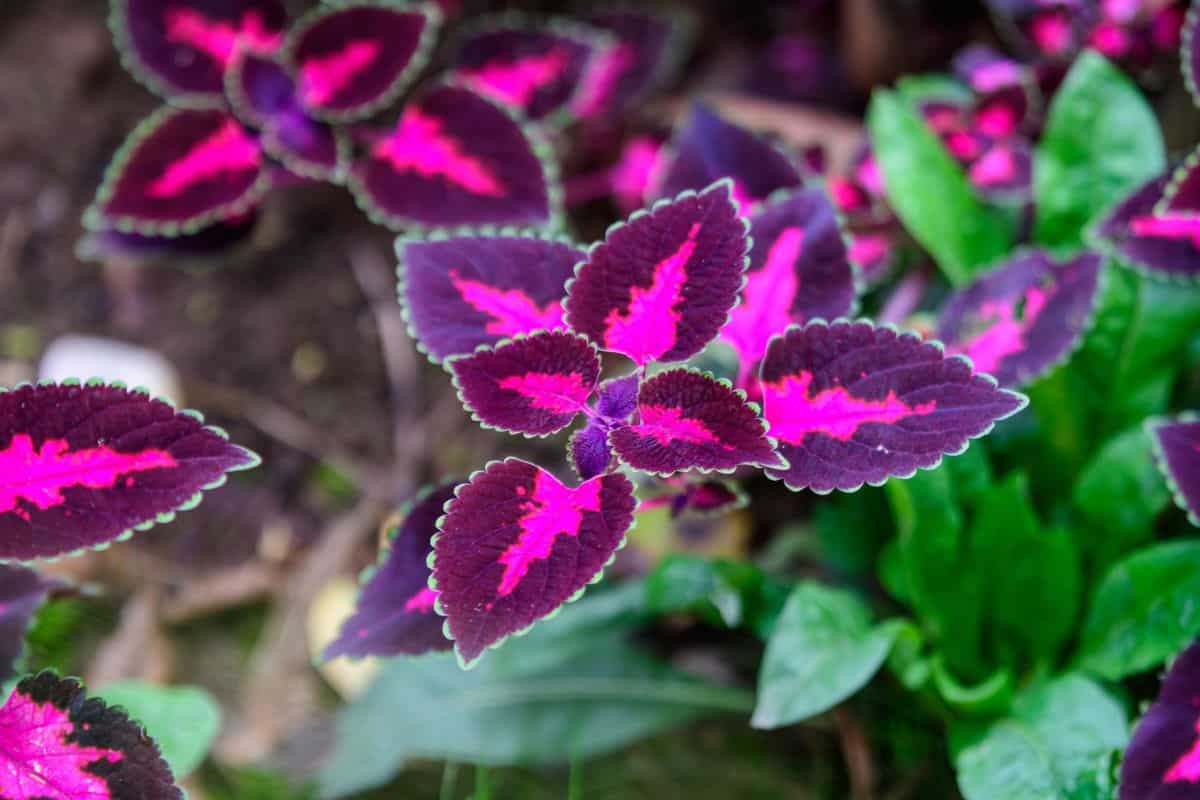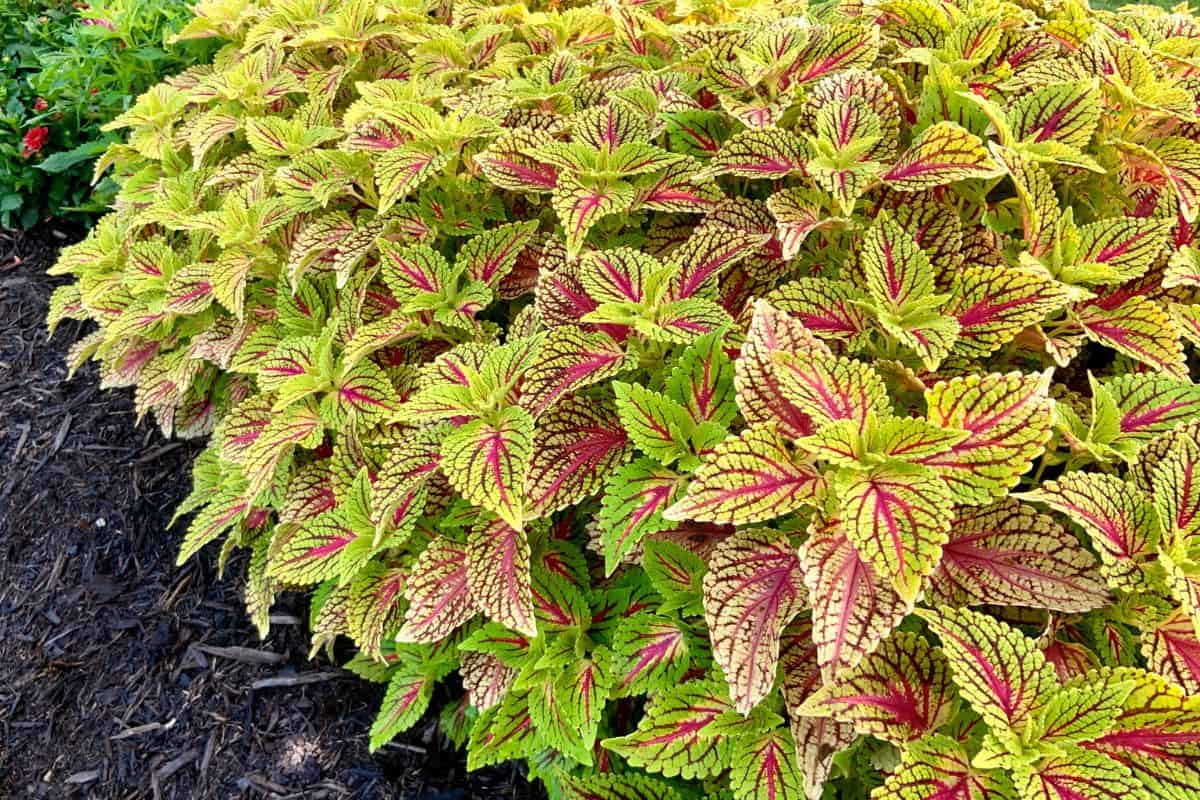Finding the right plant species to grow in your landscape can sometimes be easier said than done. Do you want to grow a coleus shrub but don't know its cold tolerance? Do these plants enjoy warmer or colder climates? We'll answer these questions and many others below!
You can usually expect coleus to withstand temperatures down to 33 degrees Fahrenheit. Since this species prefers moderate to warm year-round weather, you don't want to leave yours out if the forecast calls for freezing temperatures.
Additionally, your coleus plant should be able to withstand a light frost now and then, but too many cold spells can send it into shock and ultimately kill it.
As we start this article, we will cover all things coleus and discuss how cold one can get. Whether you recently moved to a chilly climate, are new to growing coleus, or have other related questions, we're here to help. With that said, let's jump right into this topic!
![Colorful picture of different coleus leaves with borders of different colors making it the best background, How Cold Can Coleus Tolerate? [Will One Survive The Winter]?](https://gardentabs.com/wp-content/uploads/2022/10/Colorful-picture-of-different-coleus-leaves-with-borders-of-different-colors-making-it-the-best-background.-How-Cold-Can-Coleus-Tolerate.png)
Does Coleus Like The Cold?
No. A coleus shrub isn't going to enjoy living in colder climates. Generally, this species does best in moderate weather, enjoying warm winter weather.

In addition, coleus can't withstand freezing temperatures and will die if they're exposed to these conditions for long periods. Ideally, you want to keep coleus somewhere around 60 degrees or higher, morning or night, so keep that in mind.
With that said, if there's a light frost or unforeseen cold snap, your coleus won't necessarily die. Instead, you might witness your shrub become stunted, which should wear off in a few weeks.
However, you could lose your plant forever if the weather continues to get colder than 33 degrees.
In that case, we recommend moving a coleus indoors or covering it with a thermal plant sheet until things improve and the temperature warms up.
MIXC Plant Covers With Freeze Protection
These winter plant covers keep snow and ice off your plants, have a drawstring design, work for all types of plants, come in various sizes, and are made with high-quality non-woven fabric.
Follow this link to view them on Amazon.
Will Coleus Survive The Winter Outside?

If you live somewhere with freezing winters, your coleus won't likely survive through spring. Unfortunately, this species does better in warm, tropical climates, so any severe winter weather can become a problem.
Generally, your coleus will be okay if the temperatures stay closer to 40 or 50 degrees. However, if the weather regularly drops below 33 degrees and it snows on your coleus, that's when you want to worry.
Again, tropical plants can handle one or two frosts during the winter season without dying, but they usually can't pull through if this continues to happen.
Therefore, it's a good idea to check the forecast before planting one into the soil, as you won't be able to transport it during colder periods.
You might even want to consider keeping your coleus in a pot so you can easily move it indoors if it drops below freezing.
Where Does Coleus Typically Grow?
Since coleus shrubs are native to Southeast Asia, they tend to grow in tropical or subtropical regions. Specifically, these vibrant plants are hardy to around USDA zone 10/11, so anything below that weather threshold can become a problem.
As we said above, coleus doesn't like freezing weather. So, if you are in a place with snow, frost, and ice, the winter can be the last time your plant is alive.
So, we recommend planting coleus in a location where it gets full sun and tropical weather and won't be susceptible to freezing temperatures during the fall or winter.
Even though a plant may be available at your local nursery, it doesn't mean it can survive outdoors throughout the year. Therefore, research your coleus varieties' climate preferences before putting them into the ground.
When Can You Put A Coleus Outside?

If you live in a colder region, you can usually put a coleus outside in the spring once the weather warms up. Generally, this will happen in early March, but it can vary by state/region.
For example, if you're in New York and the weather averages 30-40 degrees, you want to hold off until things improve. Your coleus will thank you and do better for the remainder of the spring/summer growing season.
Additionally, you want to ensure when your coleus goes outside again, it has plenty of sunshine. Even if you aren't in the tropics, you want to give your shrub as much sun exposure as possible.
So, some people may be able to move their coleus' outdoors in March, while others will need to wait until April or May. Every climate and garden is unique, so don't feel obliged to rush this process.
Does Coleus Prefer Full Sun Or Shade?

You generally want to plant coleus somewhere with dappled shade. So, even though your shrub will enjoy the sunlight each day, it can have breaks between the morning and afternoon.
Since the sun tends to be stronger in different regions, someone in Arizona may want to keep their coleus in partial shade, while another gardener in Oregon might wish to plant theirs in full sun.
According to Pennington Seed, coleus shouldn't get too much harsh, direct sun exposure during the heat of the day. This is typically between 1 PM and 3 PM, so try and find a spot that has relief during this time.
Furthermore, if your coleus becomes too hot, it's possible to see discoloration and a less healthy plant. Too much of a good thing can quickly become bad, which is still the case for sun exposure.
Where Should I Plant Coleus In My Garden?
The best spot for a coleus shrub is full sun/dappled shade, well-draining soil, and room to flourish. This species prefers tropical conditions, so a bit of moisture can also be beneficial.
On top of that, coleus doesn't like to sit in too much shade or water for long periods, so the sun can help dry the ground and keep them warm.
As we said above, your shrub may not be able to handle strong sunlight all morning and afternoon. Therefore, depending on your location, you might want to find a spot with a tree overhead to block the sun's rays during peak hours.
However, growing coleus too close to heavily shaded plants or structures is not a good idea, as this can lead to soil and moisture issues. Again, try and moderate the climate your plant experiences.
When a plant has too much shade, root rot and waterlogging become more prevalent. This can be deadly for coleus, so try to find a healthy balance of sun, shade, and soil moisture.
Should I Grow Coleus In A Pot?
Growing coleus in a pot can be helpful if you live somewhere with cold winters. As we covered, moving coleus indoors during colder periods is common and will keep your shrub healthy.
So, having it in a planter all year long will make transporting it easier.
Since this species tends to have a decorative look, many people plant them in pots at the front or back of their homes. This makes for an aesthetically pleasing entrance while allowing quick relocation before a sudden cold snap.
On top of that, coleus surprisingly loves growing in pots, so this is much more than a mode of transportation for them.
However, you must ensure you use a well-draining potting mix and give your coleus fertilizer during the spring/summer to keep it healthy. Many gardeners also warn against placing potted coleus in windy locations, as this can harm them.
Do Coleus Do Better In Pots Or The Ground?
Between pot-growing and in-ground growing, coleus will thrive if you give it the right conditions. However, we recommend growing coleus in a planter in colder regions.
Not only can you move your pot into the garage during a snowstorm, but you also have the ease of relocating the coleus around your yard while trying to find its permanent location.
That said, if you're somewhere tropical and prefer in-ground growing, that's perfectly fine too.
This will depend on the year-round climate and the aesthetic you're going for, so everyone is different. Again, the main factors to consider with coleus are sun exposure, soil drainage, and temperature.
Another thing to note is that if you're pot-growing coleus, choose one with a drainage hole at the bottom to prevent waterlogging and root rot.
Classic Home And Garden Patio Pot
This outdoor planter has a classic design, measures 15 inches, holds up to six gallons, features a UV-coated finish to protect it from damage, has drainage holes pre-drilled, and has excellent online reviews from customers.
Check out this planter on Amazon here.
To Finish Up

Whether you have coleus in your landscape or want to plant one, it's always good to know its cold tolerance. From what we found, coleus shrubs can't handle temperatures lower than 33 degrees and prefer weather closer to 60+ throughout the year.
In addition, these tropical plants do best in full sun in moderate regions, while dappled shade can be helpful if the sun is usually more substantial. Every climate is unique, so this is different for everyone.
Furthermore, your coleus might do better in a pot, especially if you're in a frost-prone place, so that's something to consider. We recommend giving coleus good draining soil, full-partial sun, and space to grow and flourish.
Made it to the end? Check out these other related garden articles below!
Is Rosemary Cold Hardy? [Tips For Your Garden In Winter]
Are My Marigolds Perennial Or Annual? [Breakdown By Type]
Can You Garden Year Round In Florida? [Yes! Here Are Some Tips And Tricks!]


